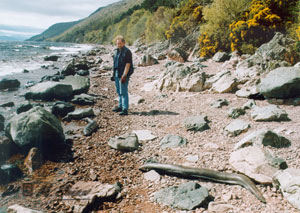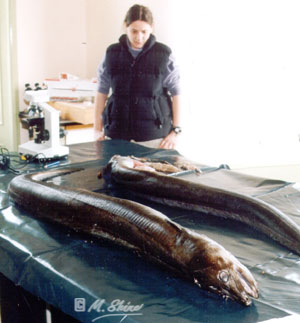'Cleansweep' 2001
Jan Sundberg at
Loch Ness

Return to Loch Ness Reflections On Saturday 5th May 2001, Operation Cleansweep came to an end. This expedition, led by Jan Sundberg of the Global Underwater Search Team (GUST) commenced on April 23rd with two objectives. 1. To search Loch Ness from end to end using a Simrad SM 2000 multibeam sonar mounted aboard Caley Cruiser's "Highland Commander II". 2. To temporarily isolate a small specimen of the Loch Ness Monster for DNA examination. For this, a large "eel trap", 7m long and 1m in diameter (The Comet trap) was used. Due to the concerns of Scottish Natural Heritage, (see Nessie Dead or Alive) the trap was used in shallow water and was unbaited. It was felt that a likely candidate for the monster might be a large eel, one of the original local theories incidentally and that eels might enter a trap while seeking cover. Some 50 hrs of sweeps with a scanning
sonar were completed without any unambiguous result.
An unrecorded contact was reported by Inge Falk, the
sonar operator while the vessel was moored for the
night in Urquhart Bay Harbour. A large layer was
also reported which dispersed at dawn. This may have
been a temperature effect or could be due to a vertically
migrating acoustic "scattering layer" of
small organisms.
Tony Harmsworth reported this to Adrian Shine who visited the site and had them transported to the his laboratory at the Centre. He identified them as conger eels (Conger conger) which are exclusively marine. This identification was confirmed by Tony Wall of the Inverness based Fish Vet Group. A post mortem also revealed that one of them had been feeding on Mackerel, another salt water fish. Both had been killed by punctures to the brain and there were signs of gaff marks. The larger eel was 6ft 1.25 ins long (1.86m) with a circumference of 22 ins (.55m) and weighed 20.8kg.
Clearly, the eels had arrived by human agency in two possible ways. They could have been thrown overboard from a passing fishing vessel. A number of trawlers had passed through the Caledonian Canal on the previous day. However, congers are seldom caught in trawls since they tend to hide in rocky ground or in wrecks. Also, one of the eels was found clear of the surf. A more likely explanation is that they had been placed by a sea angler, inspired perhaps by the publicity surrounding Mr. Sundberg's ideas about large eels. The location, directly beneath a busy lay-by suggests this. The incident is reminiscent of the
skinned dolphin, reported by the Inverness Courier,
to have been cast overboard by "the waggish crew"
of a passing fishing vessel in October 1868 to fool
"the credulous natives of Abriachan". Perhaps
today, the natives of Abriachan are less credulous! |
|||

